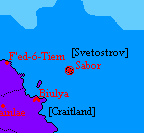Svetostrov

|
This article or section is a work in progress. The information below may be incomplete, outdated, or subject to change. |
| Holy Community of Svetostrov Светостровска Света Заједница | |||
| |||
| Motto: | |||
| Anthem: | |||

| |||
| Map versions | |||
| Capital | Sabor | ||
| Largest city | Dionisija | ||
| Official language(s) | Krasnocorian | ||
| Official religion(s) | Orthodox Nazarene
| ||
| Demonym | Svetostrovan | ||
| - Adjective | Svetostrovan | ||
| Government | Theocracy | ||
| - Bishop | Ioanicius | ||
| - Legislature | Holy Synod | ||
| Establishment | 19.III.1728 AN | ||
| Area | 4,032 km2 | ||
| Population | |||
| Currency | gold, silver | ||
| Calendar | Norton | ||
| Time zone(s) | CMT-3 | ||
| Mains electricity | 240V–60Hz | ||
| Driving side | right | ||
| Track gauge | none | ||
| National website | svetostrov.sv | ||
| National forum | |||
| National animal | |||
| National food | |||
| National drink | |||
| National tree | |||
| Abbreviation | SV, SVO | ||
The Holy Community of Svetostrov (Krasnocorian: Светостровска Света Заједница), also known as Svetostrov (Krasnocorian: Светостров) is a theocratic community located on Réunion island in north-western Apollonia. The nation shares maritime border with Craitland.
History
Before Svetostrov
Svetostrov was initially settled by Treesians in the antiquity period, and being under its rule up until 1514 AN. The Republic of Mania was based on the island from 1523 to 1542. In 1550, the Holy Empire of Réunion declared its independence and ruled over the island. Not many things are known about this period, which lasted until 1727, due to the isolationism of its government and residents.
Emergence of the Holy Community
The idea of a theocratic Orthodox Nazarene community has been a topic within the Corian Orthodox Church since the Sylvanian National Awakening.
Geography
The climate of Svetostrov is subarctic. Winters last at least ten months, with the temperatures staying below freezing point during most of the year. In the summer, which lasts two to five months, the average maximum temperatures usually range between 15 and 20 °C.

